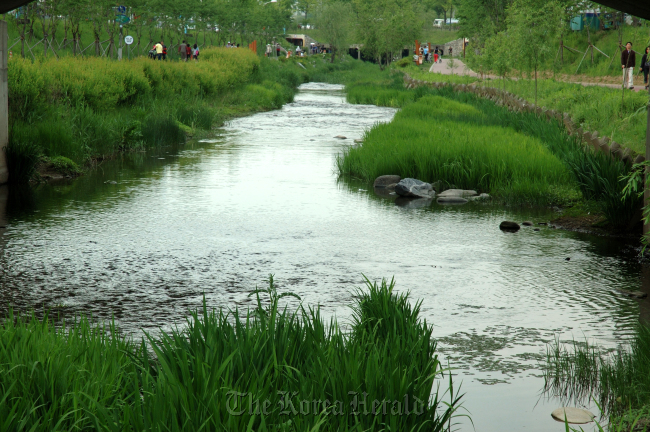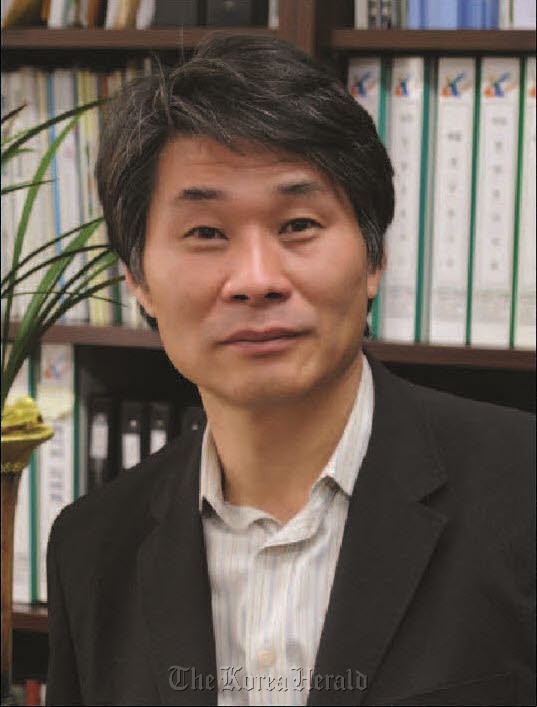Bringing rivers back to life
KC Rivertech, a local pioneer in waterway restoration, looks beyond domestic market
By Korea HeraldPublished : Nov. 8, 2012 - 20:04

The Korea Herald, in collaboration with the Korea Environmental Industry & Technology Institute, is presenting a series of articles introducing small but promising environmental tech firms. This is the ninth installment. ― Ed
“This thing here has changed my life,” said Lee Myung-hoon, CEO of KC Rivertech Co., pointing at a half-cut coconut lying on a corner of his desk.
For the past two decades, the exotic, tropical fruit has been his and his company’s best asset and weapon on the quest to bring the country’s neglected rivers, streams and ponds back to life.
“Coconut fiber logs and mats have been commonly used in European river restoration projects, as they allow plants to grow and deter erosion of the shores,” he said. “But no one in Korea tried it before we did in 1993.”
Lee, then a natural fiber merchandiser handling coconut products for mattresses and car seats, encountered local government officials who were wondering if it was possible to apply the methods used in European river restoration projects to urban streams in Korean cities.
He decided to take on the challenge, started studying by himself possible ways with information gathered online and set up KC Rivertech in 1993.
“This thing here has changed my life,” said Lee Myung-hoon, CEO of KC Rivertech Co., pointing at a half-cut coconut lying on a corner of his desk.
For the past two decades, the exotic, tropical fruit has been his and his company’s best asset and weapon on the quest to bring the country’s neglected rivers, streams and ponds back to life.
“Coconut fiber logs and mats have been commonly used in European river restoration projects, as they allow plants to grow and deter erosion of the shores,” he said. “But no one in Korea tried it before we did in 1993.”
Lee, then a natural fiber merchandiser handling coconut products for mattresses and car seats, encountered local government officials who were wondering if it was possible to apply the methods used in European river restoration projects to urban streams in Korean cities.
He decided to take on the challenge, started studying by himself possible ways with information gathered online and set up KC Rivertech in 1993.

“The flow of rivers here are unstable. Over 80 percent of total annual rainfall is concentrated in summer, which often results in rapid and unpredictable flooding,” he said. “That’s why European methods wouldn’t work.”
To balance two contrasting objectives ― erosion/flood control and ecosystem restoration ― KC Rivertech started using a variety of materials to line shores and riverbanks, such as coconut fiber logs and mats, clay blocks, rocks and in some cases, concrete structures coated with coconut fibers.
For rivers of any condition, green shores and banks are the surest solution, Lee said. It is just a matter of what materials to use and how wide the green space should be.
“Covering everything with concrete may look like the “hard defense” to manage the waterway, and green shores, using coconut and other natural materials, the softer options,” the CEO said.
But in the long term, concrete blocks grow weak, while plants and trees on shores and banks grow strong as time goes by with little need for maintenance, he explained.
As a pioneer in the field, the Gwangmyeong, Gyeonggi Province-based firm participated in most of the country’s major stream restoration projects, from one of the earliest to restore Yangje Stream in southern Seoul to a milestone project to remake Cheonggye Stream in central Seoul.
The 2005 Cheonggye Stream project has turned a paved-over, 6-kilometer waterway into a thriving stretch of public green space right in middle of Seoul’s skyscrapers.
Its popular success also sparked a river restoration boom across the country.
“It is really rewarding to see how the streams, once polluted and neglected, become the center of life again,” Lee said. “That is what motivates us most, not just profits.”
KC Rivertech now looks to apply its expertise and experience in developing countries which are now starting to take a new look at their rivers.
In China and other Asian countries, government officials are increasingly interested in restoring their rivers to their natural state.
“There is an increased level of interest, but no major project out there yet. But I am optimistic about our chances there,” he said.
By Lee Sun-young (milaya@heraldcorp.com)
-
Articles by Korea Herald




![[Herald Interview] 'Amid aging population, Korea to invite more young professionals from overseas'](http://res.heraldm.com/phpwas/restmb_idxmake.php?idx=644&simg=/content/image/2024/04/24/20240424050844_0.jpg&u=20240424200058)













![[KH Explains] Korean shipbuilding stocks rally: Real growth or bubble?](http://res.heraldm.com/phpwas/restmb_idxmake.php?idx=652&simg=/content/image/2024/04/25/20240425050656_0.jpg&u=)

